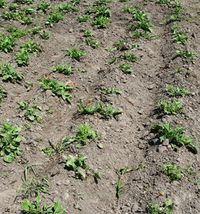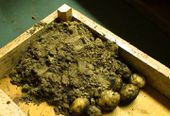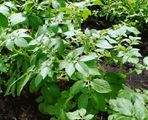Potato
Start a vegetable garden - Lesson 5: Potatoes
Chunks of information
- Today i finished planting potatoes. Our harvest of last year has all been eaten, so we're now eating potatoes bought in shops. The difference in taste is remarkable. Potatoes grow fast. In a few weeks they form big plants with many green leaves and these leaves, through the process of photosynthesis, make the potatoes grow. Potatoes contain a big percentage of starch. When potatoes grow on chemical fertilizers, they grow even faster. The tubers then taste like water. It's just starch without much taste. But potatoes grown on good compost that contains many trace minerals besides the ones given through chemical fertilizers have time to take in these minerals. They grow slower but become richer in content and taste and provide our bodies with what we need for good health. Something similar is the case for the milk we buy from cows. Many farmers feed their cows on ryegrass. This grass grows very fast on big amounts of chemical fertilizers and manure that comes from the cows who ate that grass. Because the grass grows so fast (a harvest of up to seven times in a summer is possible compared to two cuts of grass in the past), it cannot take in many minerals. The manure that comes from these cows is also depleted of especially trace minerals and other nutrients they would otherwise contain. In that way the cycle continues. Soils get poorer and poorer and so does the milk that we drink or the cheese made from this milk. Eventually it's our health that pays the price.
Hilling or earthing up potatoes
In order to prevent new potato tubers to be exposed to the light, potatoes can be hilled. I do this with a common rake, as soon as the first leaves of the potatoes appear and again a few weeks later. Tubers exposed to light become green and develop the poisonous solanine[1]. Earthing up potato plants also has the advantage that many early weeds are controlled and the plants grow better as they have more fertile and loose soil.
Because seed potatoes are planted, in most temperate climates, in a time that night frost is still possible, earthing up potatoes can also be done to prevent frost from damaging the plants. It's no problem to entirely cover the plants with soil. They quickly grow through that again.
The potatoes in the photo are of a cultivar that is harvested only in late summer. It is rather resistant against the phytophthora disease[2]. They grow slowly in the beginning and then form strong and sturdy plants.
These plants shown here got one night of frost over them, which destroyed several leaves, but potatoes generally grow quickly on and don't have lasting damage from a bit of frost.
Potatoes in cold frame
To have an early harvest of potatoes i plant tubers[3] of a fast growing variety in a cold frame in the first half of April. These potatoes can already be harvested in the beginning of June. This variety of potatoes cannot be stored long. But they taste much better and are healthier than old potatoes harvested the year before. When the weather gets hot, open the cover of the cold frame as the tubers stop growing as soon as the soil temperature reaches 80 °F (26.7 °C)
Potatoes and clay soils
This is based on my own experience, it means i haven't read evidence for this. I know that potatoes taste better when they grow on soils that contain a certain content of clay. Loam soils are good, but the best may be soils with clay formed by rivers. These potatoes taste even better than those growing on clay soils formed by seas and oceans.
The tubers of potatoes grow underground and take in a lot of minerals. Their taste changes according to the soil they grow in. Potatoes growing on sand soils normally don't taste very good.
In the photo above the potatoes grow in a cold frame in the worst part of soil in my garden. It's just yellow sand and so the potatoes should actually not have much taste. But i added much matured compost to the soil and in addition a more than normal dose of lava flour and bentonite. Lava flour for the minerals and bentonite for the clay content. And these potatoes, that we're eating these days, taste very good, they couldn't have been tastier and the structure is solid.--JE 21:17, 16 June 2012 (PDT)
Gallery
Why weeding is important... The photo shows a field with potatoes. They're all from the same species but the front and outer potatoes in the field (they're placed in circles) were weeded and in the center ones not. See also Weed control
Larva of colorado potato beetle on potato leaf (see Pests & diseases)
See also
- Gardening courses
- Knowledge base:Gardening
- Phytophthora
- Start a vegetable garden - Lesson 5: Potatoes
References
- ↑ Solanine - Wikipedia
- ↑ Phytophthora infestans - Wikipedia
- ↑ Tubers is another word for the potatoes, the stuff that you eat, but, in the case of potatoes, also are used to plant and get new potato plants. Tubers are enlarged plant structures, sometimes of roots and sometimes of stems. The plant forms them to store nutrients. Potato tubers are actually stem tubers.
External links
- Potato Wikipedia









